Electrolytic tilt sensors are capable of producing extremely accurate pitch and roll measurements in a variety of applications. They provide excellent repeatability, stability, and accuracy when operating at low frequencies, and come in a variety of packages with varying tilt range and resolution. These rugged, passive devices can be used in environments of extreme temperature, humidity, and shock.
Dual-axis, or 5-pin, sensors can be very cost effective in applications requiring both pitch and roll measurements. Off-the-shelf devices range in price from $5 to $50, and are packaged in cylindrical vials that stand from 0.5 in. to 1 in. high. Operating range of tilt is from ±10°to ±75°, depending on height.
Finding the right electrolytic tilt sensor for your application can be a complicated process. Every application requires a particular set of performance specifications that may or may not be provided by a manufacturer's off-the-shelf product. With so much at stake--the overall success of your company's product(s)--your initial evaluation of the sensor prior to design-in should be a top priority.
Narrowing the Field
Prospective electrolytic tilt sensor customers are sometimes left to their own ingenuity to determine exactly what combination of sensor attributes is best for their application. Sensors may vary in height, pin spacing, electrolyte volume and composition, and pin and glass treatment, so there are many possible combinations of attributes for each model of sensor. Recovery from an improper choice is considerably more complicated than screwing in a new light bulb. It can mean changes in board layout, firmware revisions, and different calibration procedures, any of which can cause significant delays in the development or redesign of a product.
To properly evaluate an electrolytic tilt sensor, test its performance in conditions that closely reflect the end product's actual operating environment. Vendors have signal conditioning boards that can be used to interface the sensor to a host product. Both analog and microprocessor-based modules are offered. The signal conditioning board excites the sensor and provides a linearized analog or digital output to the host. Typically a regulated DC power source is required, and provision is made for offset and gain adjustments. The board must be carefully aligned in order to provide accurate test results.
How Electrolytic Tilt Sensors Work
 |
| Figure 1. This single-axis view of a five-pin, fluid-filled tilt sensor in the upright position shows the physical relationship among the vial, pins, and fluid when the sensor is slightly tilted. |
Figure 1 shows one axis of a fluid-filled sensor tipped at ~15°. As the sensor tilts, the surface of the fluid remains level due to gravity. The fluid is electrically conductive, and the conductivity between the two electrodes is proportional to the length of electrode immersed in the fluid. At the angle shown, for example, the conductivity between pins a and b would be greater than that between b and c. Electrically, the sensor is similar to a potentiometer, with resistance changing in proportion to tilt angle.
But you can't just attach the sensor to a 6 V battery and expect it to work. The sensor is an electrolytic cell that functions somewhat similarly to a lead acid battery, but in reverse. Instead of converting chemical energy into electricity, a direct electric current induces a chemical reaction--electrolysis--in the fluid. Positive ions in the fluid migrate to the cathode, where they combine with excess electrons and lose some of their charge. Likewise, negative ions in the fluid propagate to the anode and combine with excess protons to lose their charge. If allowed to proceed, the reaction will eventually render the fluid nonconductive.
To prevent electrolysis, alternating current must be used to excite the sensor. The required frequency and symmetry of the AC waveform depend on the chemistry of the fluid and composition of the electrodes. The frequency must be high enough so that the process described above is reversible. For some electrolytes this frequency can be as low as 25 Hz. Other solutions require a minimum of 1000 Hz to 4000 Hz.
There are a few other, less pernicious characteristics of the electrolytic fluid that are important to understand:
- Total conductance varies with both temperature and tilt angle, so a measurement technique that is insensitive to total conductance is required to precisely determine the tilt angle. Sensor manufacturers can control what they call the null impedance at room temperature by changing the volume and chemical composition of the fluid. The extent to which the impedance varies with temperature and tilt depends on the physical properties of the fluid and the geometry of the device. Impedance can typically change by a factor of 20 or more over temperature and tilt.
- The sensor's angle range is a function of the volume of fluid, electrode spacing, and electrode height. Provided that the electrodes and container are tall enough not to be limiting factors, tilt measurement range is proportional to fluid volume. Because the volume of a liquid is proportional to its temperature, the overall gain, or scale factor, of the device is also proportional to temperature. If this effect is large enough to be significant, the measurement circuitry must compensate by varying gain inversely with temperature.
- The fluid may need to settle after a sudden jolt, so the measurement does not always indicate the sensor's true attitude. Manufacturers can add damping agents that change the fluid's viscosity without affecting its conductance, but these work best to filter out high-frequency vibration in an otherwise stable measurement environment. Higher viscosity can also reduce repeatability, especially at high angles, due to interaction between the fluid and its container. As previously noted, scale factor is proportional to fluid volume, and since the fluid clinging to the wall is not part of the volume interacting with the electrodes, the measurement will change depending on the extent of surface wetting.
Dual-axis sensors exhibit the same fluid characteristics as single-axis devices--but have the added complexity of interaction between the axes. Both axes share the center electrode. The four outer electrodes are ideally placed at the four corners of a perfect square. Misalignment between electrodes gives rise to cross-axis coupling that can result in significant errors.
There are at least two techniques that can be used to derive independent measurements for each axis. The first is to excite only one axis at a time, alternating between pitch and roll at an appropriate rate. In this case, the excitation must be completely disconnected from one axis while the other is being driven. Leakage to the disconnected side will adversely affect the active measurement.
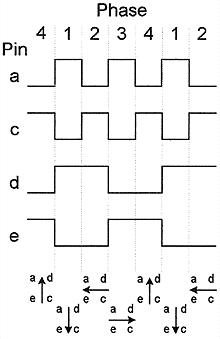 |
| Figure 2. The arrows indicate the direction of current flow that occurs when voltage waveforms apply simultaneous excitation to four outer pins. |
A second technique requires two excitation frequencies, one twice the other. Here, all four pins are driven simultaneously, and the phase of the excitation determines which axis is being measured. Figure 2 shows the waveforms applied to outer electrode pins a, c, d, and e. Beneath the waveforms, the diagrams indicate the direction of current flow through the sensor.
Note that when using the first technique, the two orthogonal axes are along the diagonals ac and de, while in the second method the two axes are aligned with the edges of the square formed by the outer electrodes. This gives rise to a small difference in sensitivity (change in signal per degree tilt) and range between the two techniques. It also requires either a physical rotation of the sensor or an electronic rotation of the axes to equate pitch and roll measurements.
A significant advantage of the four-phase drive is its simplicity. It can easily be implemented in hardware, entailing neither microcontroller overhead nor critical timing functions. Low-leakage switches are not required, and there are several ways that the signal from the center electrode can be processed to yield pitch and roll measurements.
The alternating axis drive requires less power and may be easier to switch on and off so that the sensor is excited only when a measurement is needed. Since the measurement axes are along the diagonals, the signal is slightly more sensitive to tilt, which is generally advantageous.
Figure 3 shows the major functional elements of a high-end, microprocessor-based, dual-axis tilt meter.
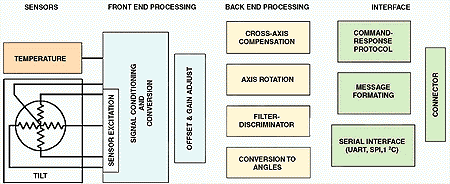 |
| Figure 3. Hardware and firmware functions are performed by a high-end, microprocessor-based, dual-axis inclinometer. |
The graph in Figure 4 is an example of a signal vs. tilt angle curve for a sensor excited with 5 V. A plot of the tangent of the tilt angle is also shown for reference. For this sensor, the signal nonlinearity relative to the tangent of the angle is less than ±0.5% for angles below ~20°.
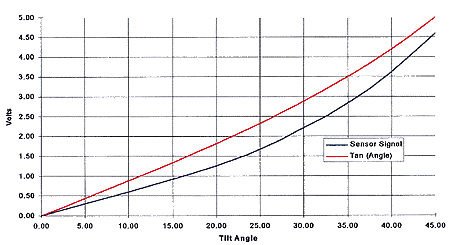 |
| Figure 4. In this sample tilt sensor signal plotted against the ideal tangent response, note that above 20° the signal output becomes nonlinear and requires calibration. |
Choosing a Sensor
The primary factors to consider when choosing an electrolytic tilt sensor are:
- Required range of tilt
- Electrolyte impedance and frequency characteristics
- Storage and operating temperature range
Sensor height is determined largely by the required range of tilt. Sensors <0.6 in. high typically have an operating range of less than ±40° tilt. Since range also depends on electrode spacing, you can do a little better by choosing a device with closer spacing, if the option exists. Electrodes are usually spaced on a 0.15 in., 0.2 in., or 0.25 in. dia. circle.
Sensor impedance and frequency characteristics are important in the design of excitation and measurement electronics. The circuitry must accommodate the wide range of impedance presented by the sensor, often a factor of 20 or more. The excitation must be an AC waveform with a frequency high enough to prevent the damaging onset of electrolysis.
The power delivered by the excitation must also be sufficiently low to prevent excessive pin heating. Pin heating can cause the shape of the meniscus at the liquid-pin interface to change, resulting in an altered signal vs. tilt angle transfer characteristic. Excessive pin heating will also raise the electrolyte temperature, which then increases in volume and produces an increased scale factor.
Although not usually one of the primary concerns when selecting an electronic device, storage temperature can be crucial to tilt sensors. The mechanical integrity of the seals is essential in preventing electrolyte leakage. Extreme ambient temperature excursions during shipping and production can be a problem for a low-cost plastic sensor intended for use in a commercial, room-temperature application. Bonding techniques that yield high-quality seals are a part of the sensor manufacturers' proprietary expertise. Glass and ceramic are popular housing materials because they can be made to produce good, high-temperature seals. Glass has the additional advantage of transparency, allowing the level and color of the electrolyte to be observed.
The operating temperature range determines the extent to which the measurement circuit must compensate for impedance and scale factor change. For many electrolytes, if the operating range is limited, the scale factor change due to electrolyte expansion and contraction can be ignored. If you are attempting to use a sensor near its maximum tilt angle, the operating temperature range may need to be limited due to temperature dependence of the nonlinear signal transfer characteristic in this region.
Proper Calibration
In many applications, absolute tilt angles in degrees, radians, mils, or fractions of a revolution are not needed. It may be sufficient to normalize the raw measurement signals from the sensor to compensate for offset and gain variation, in which case the resulting signals are proportional to the tangents of the angles. Your measurements may be repeatable for a single unit, but there may still be unit-to-unit variation due to uncompensated cross-axis coupling. If you're looking for unit-to-unit repeatability of better than 1° or 2° over a range of more than ±10° to ±15° of tilt, you probably need to calibrate in order to compensate for cross-axis coupling.
It might not be enough to consider the cross-axis variation of the sensor. In general, pitch and roll must be measured about orthogonal axes affixed to the PCB on which the sensor is mounted. Alignment of the sensor to the board can contribute as much or more to cross-axis coupling than construction tolerances of the sensor itself. Electrical characteristics of the sensor and drive electronics might also contribute.
It is interesting to note that sensors with repeatability and stability specified in hundredths of a degree can exhibit cross-axis coupling on the order of 1° or 2° at 10°-15° of tilt. The only way to compensate for this effect is to measure it and compensate by applying a 2 × 2 gain matrix. To further complicate matters, the elements of the 2 × 2 matrix will change with tilt angle unless the electrodes are exactly parallel.
This problem is not unique to dual-axis electrolytic sensors. Two single-axis sensors mounted on the same board would require similar decoupling. Dual-axis accelerometers also exhibit this problem, which may be specified on the data sheet as transverse sensitivity--in other words, the amount in percent of the signal from the sensitive axis that appears on the other axis.
Finding the Right Angle
From Figure 1 it can be seen that angles are measured in the tilted frame of reference of the sensor platform. For a single axis, it doesn't matter which frame of reference you choose, tilted or horizontal. You'll measure the same angle either way. But when both the pitch and roll axes are tilted, the angles measured directly from the sensor may not be the angles that you want.
The orientation of a tilted platform can actually be described by four pairs of angles that may all be different:
- Pitch and roll measured by an accelerometer (p, r)
- Pitch and roll derived from a fluid-filled sensor (P, R)
- A coordinate transformation, or axis rotation pair (u, f)
- The platform inclination and rotation about its normal axis (´, g)
To find the relationships between these angles, first define two sets of orthogonal axes: [t, u, v] for the tilted frame of reference of the sensor platform and [x, y, z] for the Earth's fixed (horizontal) frame of reference. A mapping from horizontal to tilted coordinates using sequential axis rotations (u, f) is given by:

which reduces to:

When measuring pitch and roll with a two-axis accelerometer, angles are measured from the gravity vector in the Earth's fixed frame of reference to the tilted sensor platform. The signals are proportional to sin p and sin r, where p and r are vertical pitch and roll angles. If we let p be the vertical angle the t axis makes with the horizontal plane, and r the vertical angle u makes with the horizontal plane, then:
p = , and
sin r = sin ![]() cos
cos
Substituting Equation (3) in Equation (2), the coordinate transformation matrix becomes:
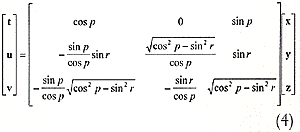
Since this is an orthogonal matrix, its inverse and transpose are equal, giving the following transformation from tilted to horizontal coordinates:
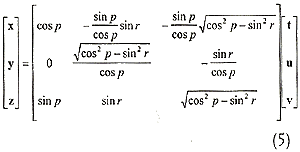
This mapping will be used later in the derivation of the relation between (p, r) and (P, R).
Signals from an electrolytic tilt sensor are proportional to tan P and tan R in the tilted frame of reference of the sensor platform (as in Figure 1). Two vectors, not necessarily orthogonal, that lie along the level surface of the fluid can be defined in [ t u v ] coordinates as:

A unit vector in the z direction of the Earth's fixed frame of reference is obtained by taking the cross product of VP and VR and dividing by the resultant magnitude:
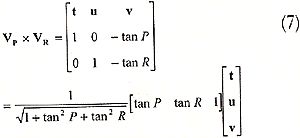
This vector is the bottom row of the transformation matrix from the tilted to the horizontal coordinate system for the electrolytic tilt sensor

Equating like terms in Equations (5) and (8) leads to:

Using trigonometric identities, these expressions can be written as follows:
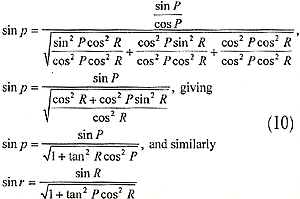
Again using trigonometric identities, we can solve for cos p and cos r:
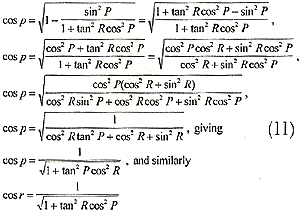
Notice that the denominators in the results of Equations (10) and (11) are the same for sin p and cos r, and for cos p and sin r. By taking ratios of the terms with like denominators, sin P and sin R can be written directly:
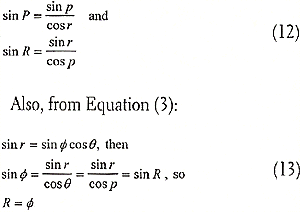
The equalities in (12) show that angles P and R measured by an electrolytic tilt sensor will always be greater than or equal to the corresponding p and r measured by an accelerometer, because the devices measure different angles using different techniques. For small angles, the differences are minor. If r < 10°, the difference between P and p is <1% for pitch <20°. The differences become more significant for angles >20°.
Neither type of sensor measures the coordinate transformation (u, f) pair directly. This pair is important because it represents rotations about independent axes affixed to the moving platform. If pitch and roll are being controlled independently, then these are the required inputs to the control loops. The pair can be calculated as follows:

The important aspect of Equation (14) is that calculating u and f is different for the two types of sensors.
For either type of sensor, a slight rotation of the device on its platform can give rise to large cross-axis error at high tilt. To determine the magnitude of cross-axis error to sensor rotation, it is best to use the fourth pair of angles (´, g), where ´ is the inclination of the platform relative to the horizontal plane and g is a rotation of the platform about its normal vector. As intended here, ´ is also the angle between the normal to the platform, or direction v, and the vertical vector, z, so the cosine of this angle is the dot product of these two vectors. The dot product is simply the row 3, column 3 entry in the coordinate transformation matrices of Equations (2), (5), and (8). Thus, the inclination, ´, of the platform is given by:

Equations (12) and (13) can be used to verify that Equation (15) is correct. You can also verify that if pitch or roll is zero from either sensor, then the inclination is equal to the non-zero angle.
For an electrolytic tilt sensor, the formula in Equation (15) can be rewritten as:
tan2![]() = tan2P + tan2R
= tan2P + tan2R
Since sin2 g + cos2 g = 1, it's easy to see that Equation (16) is satisfied by substituting:
(Since we haven't specified the direction of g, either sing or cosg can be used in the expression for tan P, as long as the other term is used in tan R.)
These expressions can now be used to evaluate the extent of cross-axis coupling that is introduced by a slight rotation of the sensor. Suppose that the requirement is for both P and R to be accurate to within ±0.5° for angles between ±60°. When both P and R are 60°, the platform inclination, ´, from Equation (16) is 67.8°. Using Equation (17) and this inclination, sing = 0.004° and g = 0.23°. For a sensor with pins spaced on a 0.25 in. dia. circle, the pins must be located to within ±0.0005 in. to achieve the required accuracy.
Summary
If you need to measure tilt, electrolytic tilt sensors are an excellent choice. Their advantages are low cost, low power consumption, repeatability, and reliability. However, they are complex devices due to their sensitivity to both internal (circuitry) and external (environmental) influences, which can alter their performance. Users unfamiliar with the technology would be well advised to work closely with vendors or consultants who can guide them through the evaluation process.
| Electrolytic Tilt Sensor Applications | |
| With expertise in magnetics, heading/attitude sensors, and electronic compassing, True North custom designs, develops, and manufactures products for undersea/marine and land use in recreational, commercial, and industrial markets, as well as embedded tilt sensor boards for applications that require highly accurate leveling or measurement data: | |
| Antenna positioning | Automotive testing |
| Avionics | Computer peripherals |
| Leveling | Package monitoring |
| Remotely operated vehicles | Slope or grade measurement |
| Survey equipment | Tilt monitoring |
| Vehicle attitude monitoring | Vibration testing |
| Virtual reality | c |